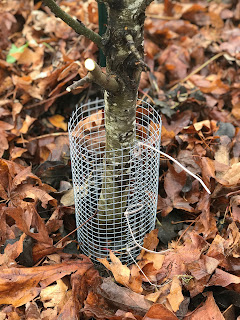 |
| Ginkgo Tree Before Clean Up. 11.1.18 |
 |
| Ginkgo Tree After Clean Up. 11.1.18 |
I delayed cutting it down entirely, and was surprised by new growth emerging from buds low on the trunk - ground level, to about 18 inches.
I left it alone last year. This Spring, I cut back some of the dead branches, and stuck them into the fencing that I encircled the tree with to reduce deer damage. The most vigorous of the new growth reached about waist level last year - maybe 18 inches of growth, then this year shot up to over 8 feet tall.
Today I removed the protective fence, cut the new growth back to the one, most vigorous, new lead, leaving some tiny shoots at ground level as back-up plan. The I cut the original trunk to a little above where the new leader emerged from the trunk, sloping the cut away from the branch point for water drainage.
Then I cut off the lowest branches from the new leader, leaving the lowest scaffold branches at about 6 feet high.
I don't know what caused the original die back. If the white spots on the trunk are indicative of a fungal infection, that does not bode well for this tree. On the other hand, we are not at two years after the die back, and the new growth was very vigorous and sturdy, so maybe whatever caused the problem is done. All we can do now is wait and see.
I provided some deer protection for the tender leader. I know, they say deer don't eat ginkgo branches. My deer have not read those books and websites, and they do sometimes eat tender ginkgo growth, or might rub antlers on the tempting straight stalk, stripping off the bark, as they do on cypress trees.
 |
| Close Up of Original Trunk and New Leader. 11.1.18 |
 |
| Final Appearance of Ginkgo Tree. 11.1.18 |





